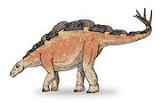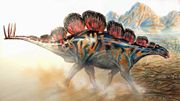
Wuerhosaurus
Encyclopedia
Wuerhosaurus is a genus
of stegosaurid
dinosaur
from the Early Cretaceous
Period of China
. As such, it was one of the last genera of stegosaurians
known to have existed, since most others lived in the late Jurassic
.
, described by Dong Zhiming
in 1973 from the Tugulu Group
in Xinjiang
, western China. The generic name is derived from the city of Wuerho.
The remains consisted of the holotype
IVPP V.4006, a skull-less fragmentary skeleton, and the paratype
IVPP V4007, three vertebrae from the tail of a second individual.
A smaller species from the Ejinhoro Formation
in the Ordos Basin in Inner Mongolia
, W. ordosensis, was formalized by the same researcher in 1993. It is based on specimen IVPP V6877, a fragmentary skeleton lacking the skull. It was found in 1988.
Susannah Maidment and colleagues proposed in 2008 that Wuerhosaurus should be considered a junior synonym of Stegosaurus
, with type species W. homheni as Stegosaurus homheni and second species W. ordosensis regarded as dubious
. This opinion has been contested, however.
W. ordosensis
 Wuerhosaurus homheni was probably a broad bodied animal. Gregory S. Paul
Wuerhosaurus homheni was probably a broad bodied animal. Gregory S. Paul
in 2010 estimated the length at 7 metres (23 ft) and the weight at four tonnes. Only a few scattered bones have been found, making a full restoration difficult. Its dorsal plates were at first thought to have been much rounder or flatter than other stegosaurids, but Maidment established this was an illusion caused by breakage: their actual form is unknown. W. homheni had a pelvis of which the front of the ilia
strongly flared outwards indicating a very broad belly. The neural spines on the tail base were exceptionally tall.
W. ordosensis was estimated by Paul to have been 5 metres (16.5 feet) long and weigh 1.2 tonnes. It too has a broad pelvis but the neural spines are shorter. The neck seems to have been relatively long.
on the end of its tail, like that of Stegosaurus
which featured four bony spikes that would most likely have been used for self-defense. A single spike was found but was seen by Dong as being positioned on the shoulder.
Genus
In biology, a genus is a low-level taxonomic rank used in the biological classification of living and fossil organisms, which is an example of definition by genus and differentia...
of stegosaurid
Stegosauridae
Stegosauridae is a family of stegosauria, large thyreophorans. They lived longer than other Stegosaurs; while all Huayangosauridae and most of basal stegosaurs died out in Tithonian - Kimmeridgian, stegosauridae survived till Middle Cretaceous. They are usually characterized by triangular plates on...
dinosaur
Dinosaur
Dinosaurs are a diverse group of animals of the clade and superorder Dinosauria. They were the dominant terrestrial vertebrates for over 160 million years, from the late Triassic period until the end of the Cretaceous , when the Cretaceous–Paleogene extinction event led to the extinction of...
from the Early Cretaceous
Cretaceous
The Cretaceous , derived from the Latin "creta" , usually abbreviated K for its German translation Kreide , is a geologic period and system from circa to million years ago. In the geologic timescale, the Cretaceous follows the Jurassic period and is followed by the Paleogene period of the...
Period of China
People's Republic of China
China , officially the People's Republic of China , is the most populous country in the world, with over 1.3 billion citizens. Located in East Asia, the country covers approximately 9.6 million square kilometres...
. As such, it was one of the last genera of stegosaurians
Stegosauria
Known colloquially as stegosaurs, the Stegosauria are a group of herbivorous dinosaurs of the Jurassic and Early Cretaceous Periods, being found mostly in the Northern Hemisphere, predominantly in what is now North America and China....
known to have existed, since most others lived in the late Jurassic
Jurassic
The Jurassic is a geologic period and system that extends from about Mya to Mya, that is, from the end of the Triassic to the beginning of the Cretaceous. The Jurassic constitutes the middle period of the Mesozoic era, also known as the age of reptiles. The start of the period is marked by...
.
Discovery and species
Wuerhosaurus homheni is the type speciesType species
In biological nomenclature, a type species is both a concept and a practical system which is used in the classification and nomenclature of animals and plants. The value of a "type species" lies in the fact that it makes clear what is meant by a particular genus name. A type species is the species...
, described by Dong Zhiming
Dong Zhiming
Dong Zhiming , from the Institute of Vertebrate Paleontology and Paleoanthropology in Beijing, is one of China's leading paleontologists. He began working at the IVPP in 1962, learning from Yang Zhongjian who was director at the time...
in 1973 from the Tugulu Group
Tugulu Group
The Tugulu Group is a geological formation in Xinjiang, China whose strata date back to the Early Cretaceous. Dinosaur remains are among the fossils that have been recovered from the formation.-Dinosaurs:-Pterosaurs:-Crurotarsans:-References:...
in Xinjiang
Xinjiang
Xinjiang is an autonomous region of the People's Republic of China. It is the largest Chinese administrative division and spans over 1.6 million km2...
, western China. The generic name is derived from the city of Wuerho.
The remains consisted of the holotype
Holotype
A holotype is a single physical example of an organism, known to have been used when the species was formally described. It is either the single such physical example or one of several such, but explicitly designated as the holotype...
IVPP V.4006, a skull-less fragmentary skeleton, and the paratype
Paratype
Paratype is a technical term used in the scientific naming of species and other taxa of organisms. The exact meaning of the term paratype when it is used in zoology is not the same as the meaning when it is used in botany...
IVPP V4007, three vertebrae from the tail of a second individual.
A smaller species from the Ejinhoro Formation
Ejinhoro Formation
The Ejinhoro Formation is a geological formation in Inner Mongolia, north China, whose strata date back to the Early Cretaceous period.Dinosaur remains are among the fossils that have been recovered from the formation.-Dinosaurs:...
in the Ordos Basin in Inner Mongolia
Inner Mongolia
Inner Mongolia is an autonomous region of the People's Republic of China, located in the northern region of the country. Inner Mongolia shares an international border with the countries of Mongolia and the Russian Federation...
, W. ordosensis, was formalized by the same researcher in 1993. It is based on specimen IVPP V6877, a fragmentary skeleton lacking the skull. It was found in 1988.
Susannah Maidment and colleagues proposed in 2008 that Wuerhosaurus should be considered a junior synonym of Stegosaurus
Stegosaurus
Stegosaurus is a genus of armored stegosaurid dinosaur. They lived during the Late Jurassic period , some 155 to 150 million years ago in what is now western North America. In 2006, a specimen of Stegosaurus was announced from Portugal, showing that they were present in Europe as well...
, with type species W. homheni as Stegosaurus homheni and second species W. ordosensis regarded as dubious
Nomen dubium
In zoological nomenclature, a nomen dubium is a scientific name that is of unknown or doubtful application...
. This opinion has been contested, however.
Distribution
W. homheni- Tugulu GroupTugulu GroupThe Tugulu Group is a geological formation in Xinjiang, China whose strata date back to the Early Cretaceous. Dinosaur remains are among the fossils that have been recovered from the formation.-Dinosaurs:-Pterosaurs:-Crurotarsans:-References:...
W. ordosensis
- Ejinhoro FormationEjinhoro FormationThe Ejinhoro Formation is a geological formation in Inner Mongolia, north China, whose strata date back to the Early Cretaceous period.Dinosaur remains are among the fossils that have been recovered from the formation.-Dinosaurs:...
Description

Gregory S. Paul
Gregory Scott Paul is a freelance researcher, author and illustrator who works in paleontology, and more recently has examined sociology and theology. He is best known for his work and research on theropod dinosaurs and his detailed illustrations, both live and skeletal...
in 2010 estimated the length at 7 metres (23 ft) and the weight at four tonnes. Only a few scattered bones have been found, making a full restoration difficult. Its dorsal plates were at first thought to have been much rounder or flatter than other stegosaurids, but Maidment established this was an illusion caused by breakage: their actual form is unknown. W. homheni had a pelvis of which the front of the ilia
Ilium
-Places:* Ilion or, Latinized, Ilium, another name for the legendary city of Troy, hence the title of Homer's Iliad*Ilium , an ancient city in Epirus...
strongly flared outwards indicating a very broad belly. The neural spines on the tail base were exceptionally tall.
W. ordosensis was estimated by Paul to have been 5 metres (16.5 feet) long and weigh 1.2 tonnes. It too has a broad pelvis but the neural spines are shorter. The neck seems to have been relatively long.
Paleobiology
Wuerhosaurus was lower to the ground than most other stegosaurids; scientists believe that this was an adaptation to let it feed on low-growing vegetation. Wuerhosaurus, like other stegosaurids, perhaps had a thagomizerThagomizer
Thagomizer is an informal name for the distinctive arrangement of four to ten spikes on the tails of stegosaurid dinosaurs. These spikes are believed to have been a defensive measure against predators.-Paleobiology:...
on the end of its tail, like that of Stegosaurus
Stegosaurus
Stegosaurus is a genus of armored stegosaurid dinosaur. They lived during the Late Jurassic period , some 155 to 150 million years ago in what is now western North America. In 2006, a specimen of Stegosaurus was announced from Portugal, showing that they were present in Europe as well...
which featured four bony spikes that would most likely have been used for self-defense. A single spike was found but was seen by Dong as being positioned on the shoulder.
External links
- Wuerhosaurus at Thescelosaurus!

